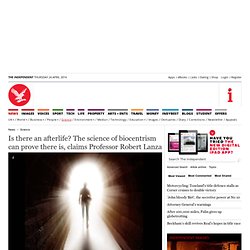

A Cavendish quantum mechanics primer. Interview with Nobel prize candidate Sir Roger Penrose and Stuart Hameroff. 1001.3080. Teach yourself Neuroscience. Discovery of quantum vibrations in 'microtubules' inside brain neurons supports controversial theory of consciousness. Consciousness in the universe: A review of the ‘Orch OR’ theory. Open Access Highlights The Orch OR theory proposes quantum computations in brain microtubules account for consciousness.

Microtubule ‘quantum channels’ in which anesthetics erase consciousness are identified. Evidence for warm quantum vibrations in brain microtubules is cited. Interference of microtubule vibrations are ‘beat frequencies’ seen as EEG. Orch OR links consciousness to processes in fundamental space–time geometry. Abstract The nature of consciousness, the mechanism by which it occurs in the brain, and its ultimate place in the universe are unknown. 1. Consciousness implies awareness: subjective, phenomenal experience of internal and external worlds. Three general possibilities regarding the origin and place of consciousness in the universe have been commonly expressed. Consciousness is not an independent quality but arose, in terms of conventional physical processes, as a natural evolutionary consequence of the biological adaptation of brains and nervous systems. 2. 2.1.
Discovery of quantum vibrations in 'microtubules' inside brain neurons supports controversial theory of consciousness. Quantum Consciousness. Orchestrated objective reduction. Orchestrated objective reduction (Orch-OR) is a controversial 20-year-old theory of consciousness conceptualized by the theoretical physicist Sir Roger Penrose and anesthesiologist Stuart Hameroff, which claims that consciousness derives from deeper level, finer scale quantum activities inside the cells, most prevalent in the brain neurons.

It combines approaches from the radically different angles of molecular biology, neuroscience, quantum physics, pharmacology, philosophy, quantum information theory, and aspects of quantum gravity.[1] The Penrose–Lucas argument[edit] The Penrose–Lucas argument states that, because humans are capable of knowing the truth of Gödel-unprovable statements, human thought is necessarily non-computable.[23] In 1931, mathematician and logician Kurt Gödel proved that any effectively generated theory capable of proving basic arithmetic cannot be both consistent and complete.
Criticism of the Penrose–Lucas argument[edit] Objective reduction[edit] Motivation[edit] Consciousness and the Universe: Quantum Physics, Evolution, Brain & Mind: Roger Penrose, Stuart Hameroff, Henry P. Stapp, Deepak Chopra: 9780982955208: Amazon.com. Is there an afterlife? The science of biocentrism can prove there is, claims Professor Robert Lanza - Science - News. While the religious would argue that life on earth is a mere warm up for an eternity spent in heaven or hell, and many scientists would dismiss the concept for lack of proof – one expert claims he has definitive evidence to confirm once and for all that there is indeed life after death.

The answer, Professor Robert Lanza says, lies in quantum physics – specifically the theory of biocentrism. The scientist, from Wake Forest University School of Medicine in North Carolina, says the evidence lies in the idea that the concept of death is a mere figment of our consciousness. Professor Lanza says biocentrism explains that the universe only exists because of an individual’s consciousness of it – essentially life and biology are central to reality, which in turn creates the universe; the universe itself does not create life. The same applies to the concepts of space and time, which Professor Lanza describes as “simply tools of the mind”.